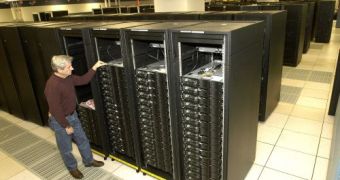IBM announced last weekend that it had managed to break down the supercomputing's petaflop barrier with its RoadRunner system, which is capable of processing more than one thousand trillion (one quadrillion) sustained floating-point operations per second. Now, it is time for supercomputer developers to turn their attention towards the next performance limit and try to create the exascale system.
The next goal should be breaking the exaflop barrier, that is a million trillion calculations per second, a quntillion in short, which is a thousand time faster than the petaflop. Obviously, this will catch the attention of the developers of the world's fastest supercomputers.
The RoadRunner, the supercomputer designed to establish the new record, was built by IBM at the Los Alamos National Laboratory, and ate around $100 million.
The whole movement in terms of compute performance and supercomputing began eleven years ago when Sandia National Laboratories developed the ASCI Red supercomputer. The system cost $55 million back then and it represented a pioneer in the field, just like IBM's system is today. The ASCI Red managed to break the teraflop barrier, namely one trillion calculations per second. That speed doesn't seems too impressive today, as there are blade systems that can get pretty close to that and cost somewhere in the low six figures.
The researchers are quite sure they would be able to break the next barrier in another eleven years period. At the International Supercomputing Conference which will be held next week in Dresden, Germany, Jack Dongarra, a professor of computer science at the University of Tennessee and a distinguished research staff member at Oak Ridge National Laboratory, is expected to give a presentation on exaflop systems "in the year 2019".
Dongarra said during a telephone interview that the performances obtained so far were predictable, with the Cray Y-MP computer developed for Lawrence Livermore National Laboratory represented 22 years ago the first gigaflop system, and ASCI Red going one thousand times faster eleven years ago.
"The projection is very clear -- in 11 years we will have an exaflop," said Dongarra, while expressing his belief that the Top 500 computing list would be mentioning only at least petaflop systems by then. His sayings are based on the fact that ASCI Red system has been left behind the list a long time ago and new machines are coming to the top every year. The list, with Dongarra as co-compiler, is updated twice every year.
RoadRunner will be released next week and it is expected to hold the first position in the Top 500.
Yet, Dongarra fears that an exaflop-capable system won't be able to be developed at the same rate of movement recorded for the petaflop system. "It will take an incredible amount of effort," he said.
According to Dongarra, the exceptional achievement that RoadRunner brought to IBM is the programming which allowed the system to utilize different processor technologies - AMD Opteron, and Cell. "It's a tour de force of programming," said Dongarra.
In order to achieve exascale systems, new programming languages and algorithms should be created by developers so that high degrees of concurrency to complete calculations rapidly could be reached. The main obstacle in getting to that level of programming and in developing and using new methods, said Dongarra, could be the same blunder that can slow down the development of the exaflop systems.

 14 DAY TRIAL //
14 DAY TRIAL //